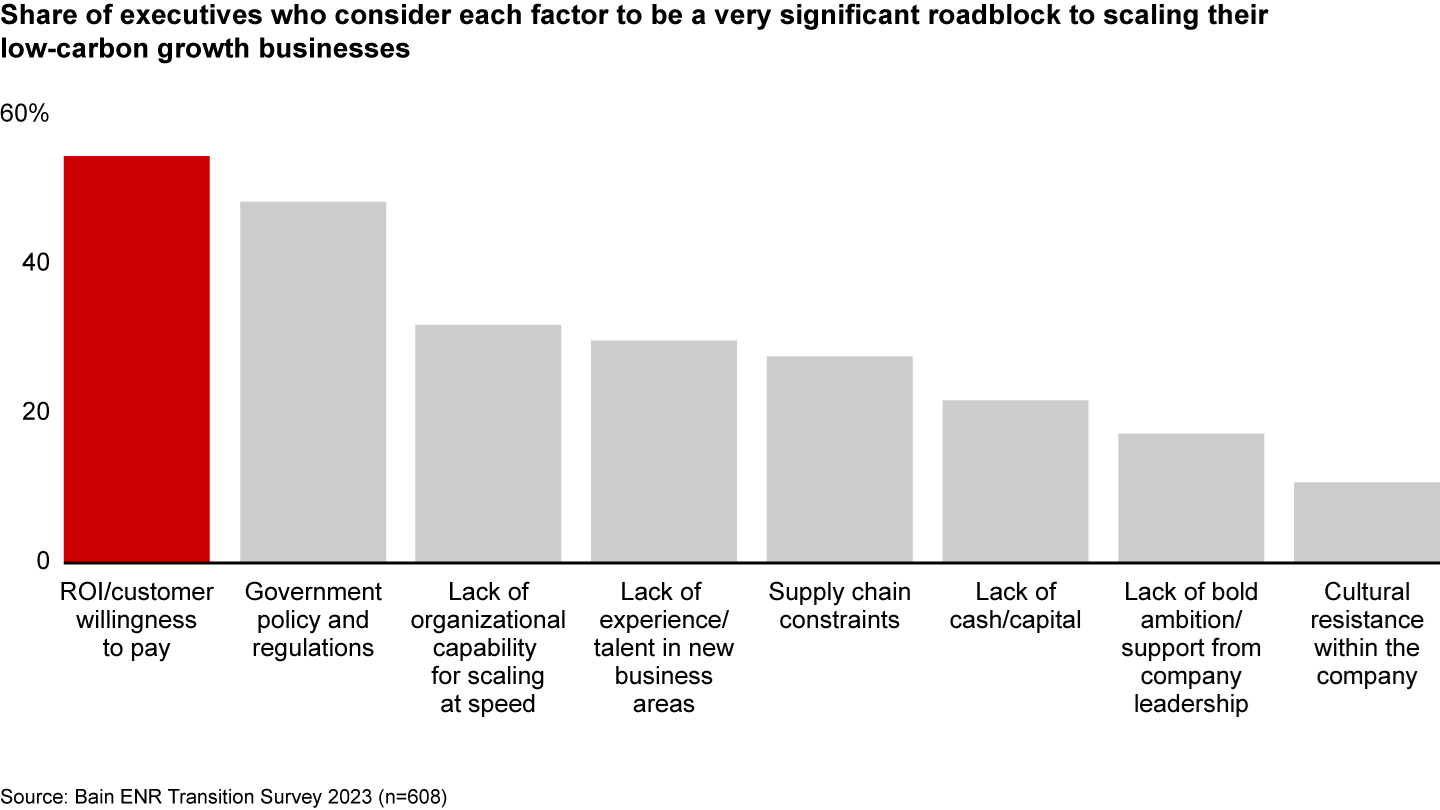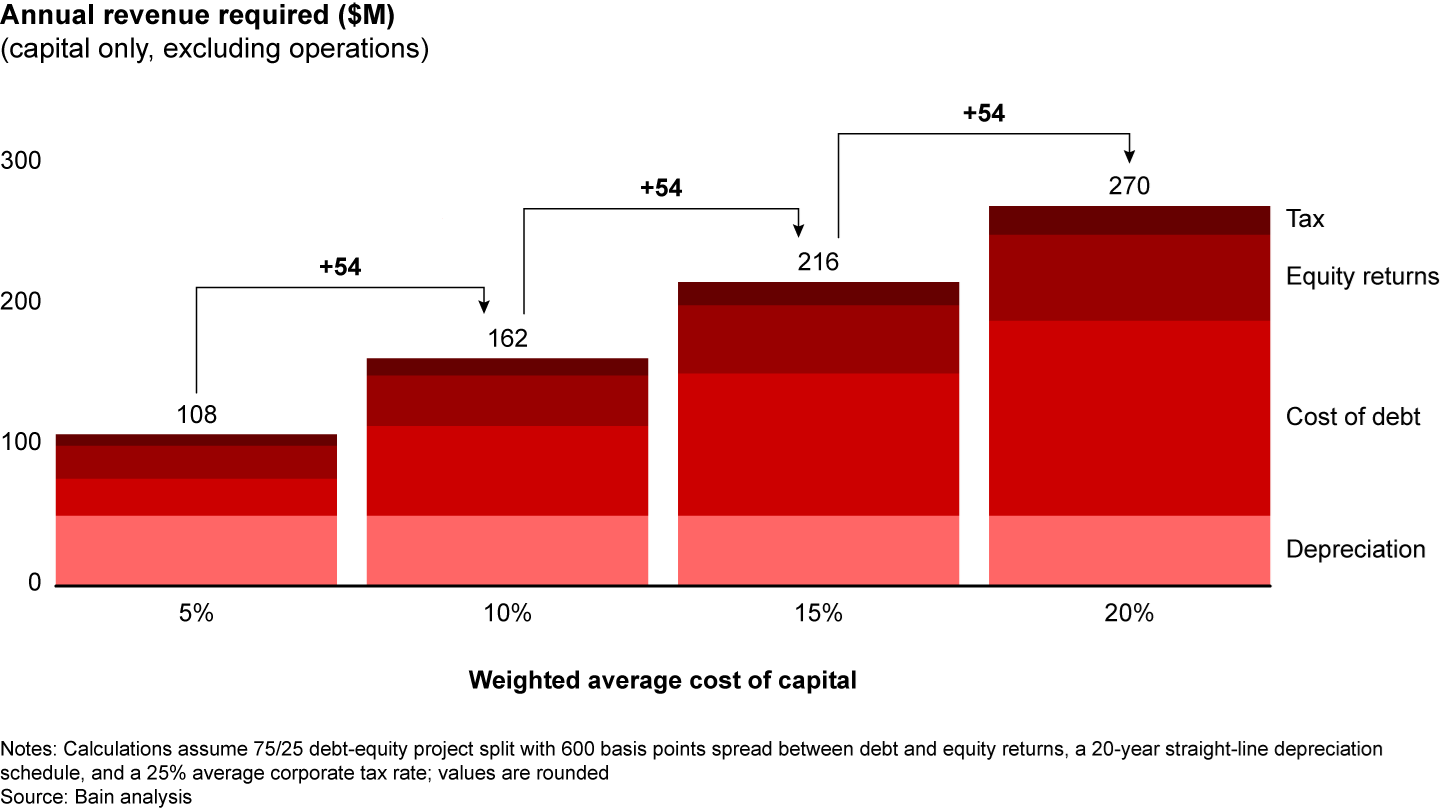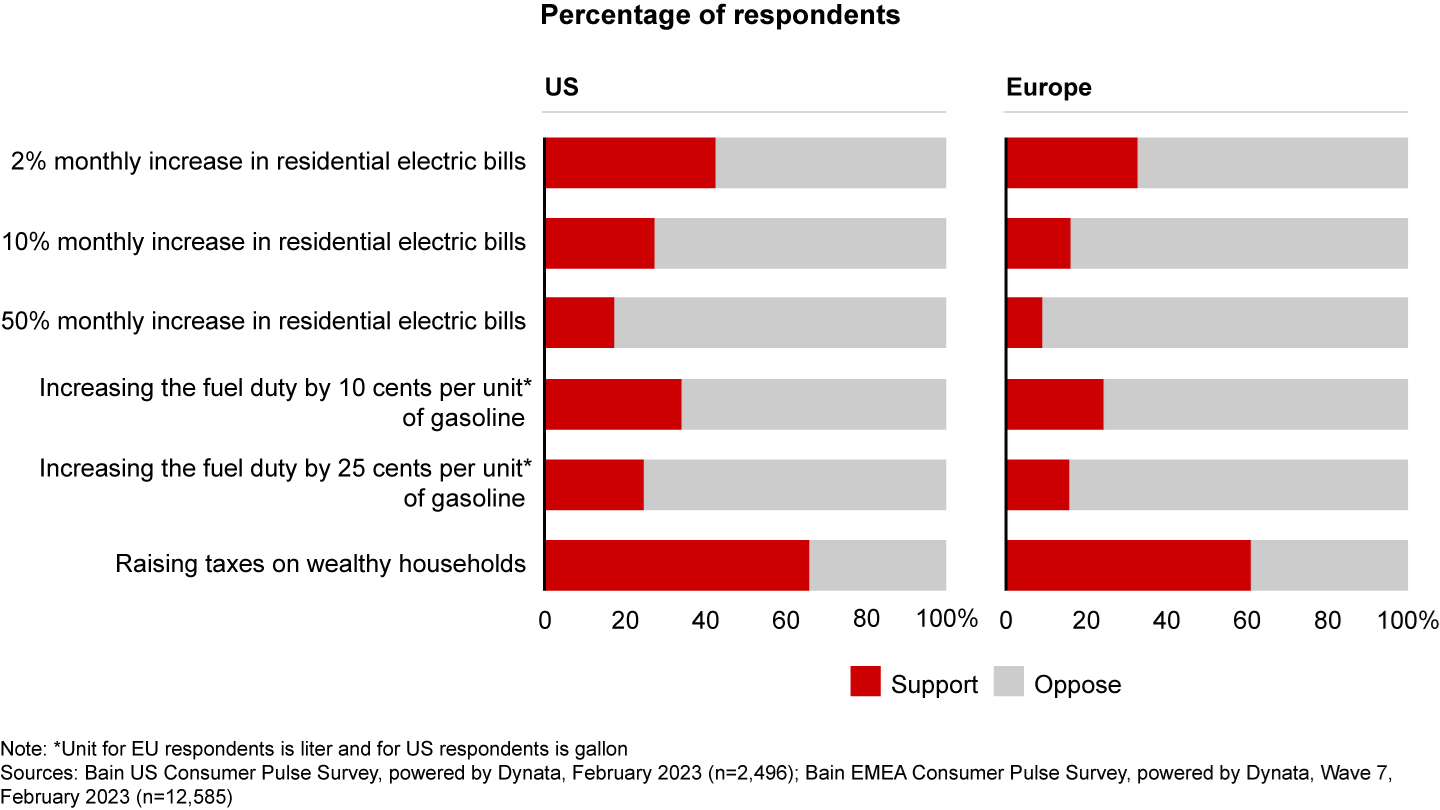The Visionary CEO’s Guide to Sustainability

At a Glance
- The energy transition would generate at least $55 billion in new earnings each year if the world approached the annual investment level required for net zero.
- Unlocking the trillions of capital dollars available remains difficult; many companies struggle to chart clear pathways to investment returns on their low-carbon projects.
- Leading companies are using policy, commercial capabilities, creative financing, cost discipline, and other strategies to make the math work for their low-carbon investments.
This article is part of Bain’s 2023 CEO Sustainability Guide
Delivering on the energy transition’s ambitions comes down to economics: How can the world make the $4.6 trillion annual investment required for net zero pencil out?
As investors and other stakeholders form global coalitions such as the Glasgow Financial Alliance for Net Zero (GFANZ), there’s no question that there are trillions of capital investment dollars worldwide looking for a home in low-carbon energy systems. Capital seeks returns. If low-carbon capital investments approached the annual $4.6 trillion that the International Energy Agency (IEA) estimates is required by 2030 to achieve net-zero carbon emissions by 2050, the energy transition would generate a new $55 billion earnings pool each year—a low-end estimate if one assumes an average 20% equity weighting for projects and a 6% return on that equity. That’s the generational upside that so many companies are pursuing around the world as they work to scale up their new energy-related businesses.
Despite the opportunity, less than $2 trillion per year is being deployed into clean energy worldwide across the private and public sectors, according to IEA data. In Bain’s 2023 survey of more than 600 energy and natural resource (ENR) executives, respondents confirmed that they expect to allocate only about 25% of total capital to new low-carbon growth areas. This is largely unchanged from last year’s survey and consistent with the capital allocation data sourced through Bain’s analysis of 125 of the top energy and natural resource companies by market capitalization in each sector. What’s more, according to that same data, almost half of the enormous cash windfall those companies received over the last two years was returned to shareholders rather than reinvested into new low-carbon projects.
What’s going on? Although the challenges are multifaceted and complex, ENR executives said in our 2023 survey that the most formidable constraint on scaling up low-carbon systems isn’t access to capital or even supply chain challenges—it’s securing sufficient returns on investment and customer willingness to pay higher prices to cover that capital, once deployed (see Figure 1). Put another way, most companies have ample access to capital markets. It’s customer revenue they’re hunting in order to grow these businesses by an order of magnitude in coming years. Until that problem is solved, the $4.6 trillion global investment goal will remain out of reach.
Executives say the greatest obstacles to scaling low-carbon businesses are customers’ unwillingness to pay higher prices and the difficulty of ensuring adequate returns on investment


Understanding the math of capital formation
The energy and natural resource industries are exceptionally capital intensive, as their executives and investors know all too well. For many low-carbon projects, the largest input cost is capital. Put simply, for any project to be built, capital providers must first ask and answer the questions, “who will pay? for how long?” and “is that enough?” Most capital allocators will be hesitant to invest before there are clear signals that demand will be there and returns will follow.
To give a clearer picture of the math surrounding capital formation, a simple rule of thumb is that for every $1 billion in capital invested in a low-carbon project, roughly $60 million in revenue must be collected to cover returns on equity, debt servicing costs, and taxes, assuming a low-risk asset with a 5% cost of capital. That asset must also be depreciated, increasing the revenue required to about $108 million per year, assuming a 20-year useful life. If risk increases, and with it cost of capital, the revenue that must be collected from customers grows further: For every 500 basis points increase in the cost of capital, the annual revenue requirement increases by almost $55 million (see Figure 2). So, as central banks increase interest rates, the effective cost of any given low-carbon project increases as well. At a 10% average cost of capital, every $1 billion in capital deployed requires about $160 million in revenue from customers each year. Furthermore, all of these costs come before operating and fuel expenses.
At least $108 million in annual revenue is required to form $1 billion in capital for a low-risk asset


The trouble is that although consumers are concerned about climate change, data suggests that they may not be willing to pay higher bills to help combat it. Recent Bain surveys found that less than half of US and EU consumers are willing to pay even a small increase in their residential electric bill or fuel price to reduce emissions. Instead, they prefer raising taxes on wealthy households, suggesting that consumers believe government should intervene to bring down prices of new technologies (see Figure 3).
Most consumers aren’t willing to pay higher prices for reducing greenhouse gas emissions


For low-carbon projects serving business customers, such as sustainable aviation fuel (SAF) or chemicals, generating revenue requires finding a counterparty willing to pay a premium above the cost of legacy products and to provide longer-term revenue certainty. But as we discuss in our brief about a net-zero path for commercial aviation, the SAF premium can be significant.
Further barriers to capital formation and attractive returns can emerge based on an individual company’s financial model and investor value proposition. Across energy and natural resource sectors, different companies have different investor value propositions, with different implied balances of growth, risk, and return. Utilities investors generally seek low-risk, comparatively lower-return, asset deployment—a business model akin to a bank financing mortgages. By contrast, oil and gas investors understand that their sector’s stocks are subject to large swings in returns as energy prices move. They’re comfortable with that added risk because it’s worth it to them to pursue higher returns (along with dividend payments), with potentially fast or lumpy payback periods based on commodity cycles. A utility investor would likely be uncomfortable if asked to finance a perfectly economic but risky (high-return) project, which is why US utilities have continued to shed non-regulated assets over the last decade. There would be similar challenges when asking an oil and gas investor to finance renewables projects with lower risk and lower return on capex than the existing base portfolio. Both types of projects may be perfectly viable, but different investors would value those risk/return profiles differently.
Tactically, a company’s capital allocation and approvals procedures can also pose a challenge. Existing capital allocation processes may not be set up to effectively handle low-carbon projects’ novel (from the standpoint of the legacy company) risk/return profiles. Something as simple as how a project’s capital committee template is set up—and the differences in that template’s underlying assumptions compared with a typical project—can make project approvals difficult to secure.
Practical solutions for executives
In our experience working with energy and natural resource companies worldwide, focusing on one or more of the strategies below can bolster the case for capital allocations and increase a project’s return on investment.
Open new markets via policy. In many cases, pure market economics will be insufficient to create low-carbon revenue at the necessary scale or pace. Policies—including subsidies, taxes, and demand-side regulations requiring industries to use these new energies—will be required. At leading companies, management teams work with a broad range of stakeholders to use policy to carve out demand and associated revenues. Those that proactively shape policy and stakeholder landscapes will generate outsize returns and better manage risks, while helping secure corporate decarbonization commitments.
Policy’s financial upside for energy companies can be startling. US agri-tech company Green Plains is simultaneously accelerating its decarbonization plans while generating shareholder returns. It’s making optimal use of tax credits offered by the US Inflation Reduction Act (IRA) for carbon capture, utilization, and sequestration (CCUS) and carbon intensity reduction, as well as carbon credits offered by various North American governments. As a result, the company intends to more than halve the carbon intensity of its ethanol production platform while delivering a conservatively estimated annualized profit increase of $200 million to $280 million in EBITDA by 2027 over an estimated 1 billion gallons of ethanol production. This is one of many recent examples in the United States following the IRA’s passage.
Neste, a biofuels producer based in Finland, has had an active presence in climate conversations during crucial policy-shaping moments. The company provides insights and analysis on, for example, emission reduction targets and renewable transportation fuels through public consultations and direct engagement with government officials and politicians. Neste also participates in industry associations that often have an instrumental role in informing government policy.
Build commercial muscles and mindsets. Leading companies also focus on developing pockets of customers who are willing to commit to their low-carbon product or service, often leveraging government incentives. This requires a deep customer-facing commercial capability that for many traditional energy and resource companies is a new muscle.
Examining potential customers’ environmental activities and commitments can signal whether those customers might be willing to pay a green premium. One renewable energy company developing a clean hydrogen project started with a list of thousands of potential customers in its most attractive segments and narrowed it down to the 40 most likely customers. That allowed it to focus its sales efforts on targeted conversations that resulted in an offtake agreement that made the project economically viable.
In the biochemicals sector, Genomatica found an early partner in Lululemon to bring to market plant-based nylon that doesn’t rely on petrochemicals. (For more examples of commercial excellence in the energy and natural resource transition, see our briefs “Unlocking Hydrogen Projects with a Customer-Centric Approach” and “Finding the Sustainable Advantage in Chemicals.”)
In another example, utilities are increasingly considering how to reframe bills to customers. For example, one utility is contemplating adding to each customer bill the effective gasoline savings associated with charging an electric vehicle (EV) at home. EV charging drives up electricity bills, but taking a “total energy wallet” view and talking with customers about the related gasoline savings can help consumers more willingly accept higher utility prices. This would be natural to many other industries, but for utilities, it represents a new mindset.
Keep costs down. A traditional approach to making the math work can also be crucial in low-carbon technologies and markets: Become a low-cost, scale leader. Businesses that grow large enough can receive advantaged access to key components at the lowest costs, thereby freeing up room for growth. For companies like utilities, which collect revenue from customers on an average charge basis, eliminating costs can help fund low-carbon investments.
Find creative financing solutions and reduce the cost of capital. All things being equal, given the amount of global capital chasing low-carbon opportunities, low-cost capital should be available for any feasible project. But companies often overlook creative balance sheet options to maximize returns for their shareholders and secure better infrastructure financing. Too often, companies assume all low-carbon projects should be financed by the corporate balance sheet, where investors may not appropriately value the risk/return profile of the proposed investment. Creative financing solutions can bridge the gap. In the offshore wind industry, for example, complex farm-down schemes are a well-established practice to lower the project’s effective cost of capital and generate returns for the developer.
Leading companies seriously consider alternatives, such as taking a development fee and transferring the asset to another advantaged source of capital, lowering overall project costs. Taking a more active approach to pursuing partnerships with investors could also prove valuable. For example, oil and gas companies could coinvest with infrastructure funds on lower-risk, lower-return projects; with development banks for projects in emerging markets; or with private capital investors willing to take on riskier, longer-term projects.
Start with the sound strategy
There are many successful low-carbon businesses already increasing revenue and generating strong returns. Each year, renewables deployment is growing, with 2022 seeing a record net addition of more than 250 gigawatts of wind and solar capacity. That said, for every company achieving leading returns and growth, there is another struggling, as our survey results show.
Developing a clear strategy that directly addresses the fundamentals of return generation in low-carbon markets is critical. With over $150 trillion in investor capital committed toward net-zero targets by GFANZ alone, being “just another provider of capital” isn’t a recipe for attractive returns. Energy and natural resource companies have real competitive advantages against pure-play capital providers, but they need the right capabilities to exploit those advantages and generate returns. Policy, commercial capabilities, creative financing, and cost discipline are a starting list of tools for supporting capital formation; there are others. While the global picture of the energy transition is complex, companies that are proactive, bold, and focused on the fundamentals of return generation will be able to overcome one of the most common challenges to scaling a low-carbon business. They’ll also help move the world closer to its $4.6 trillion goal, one project at a time.